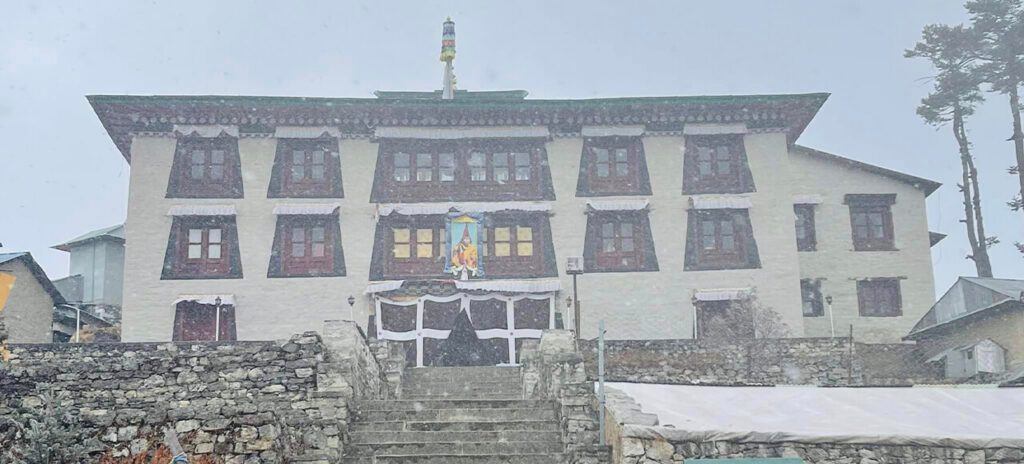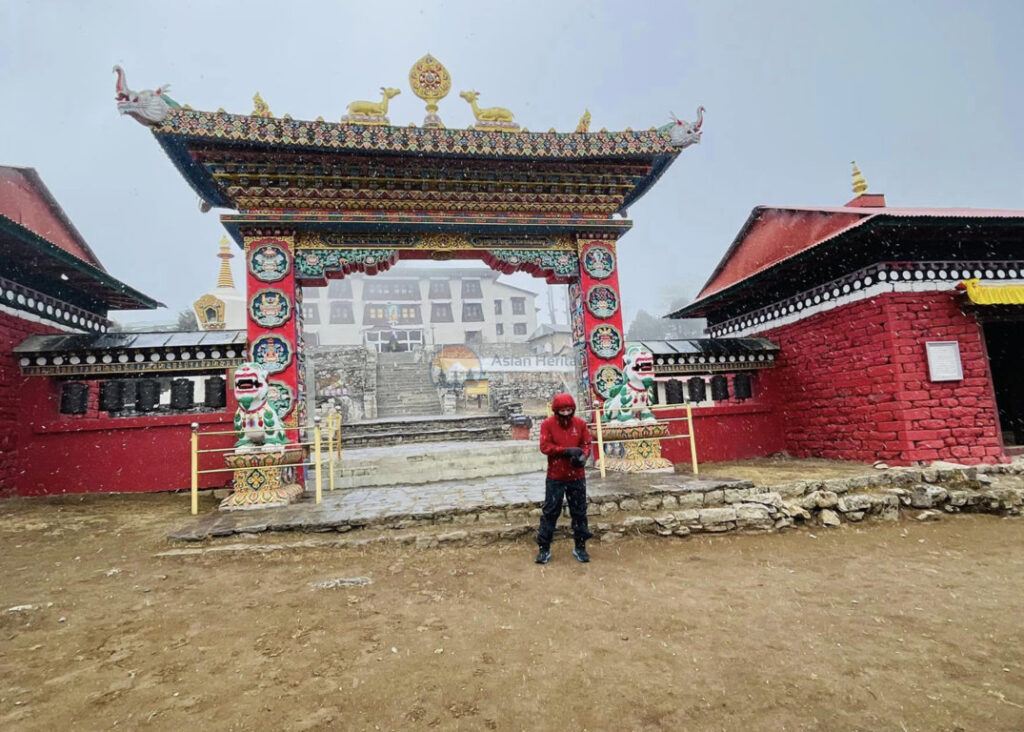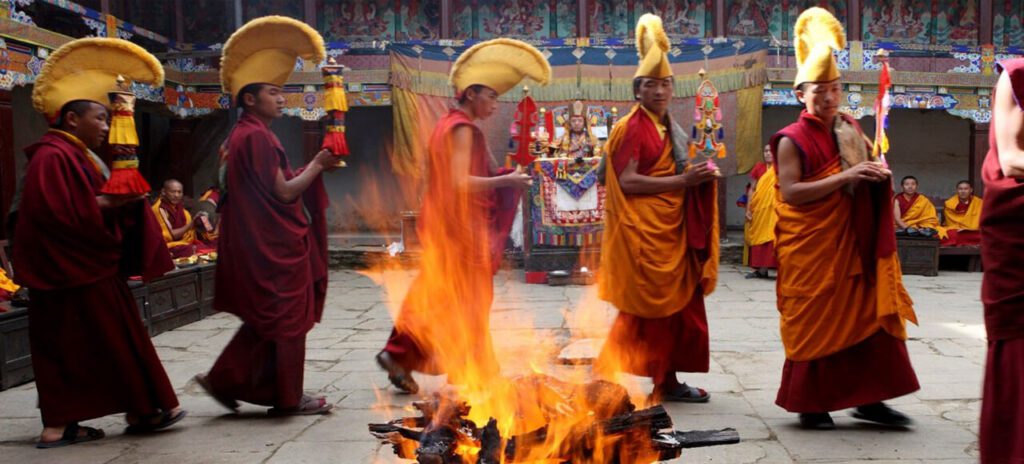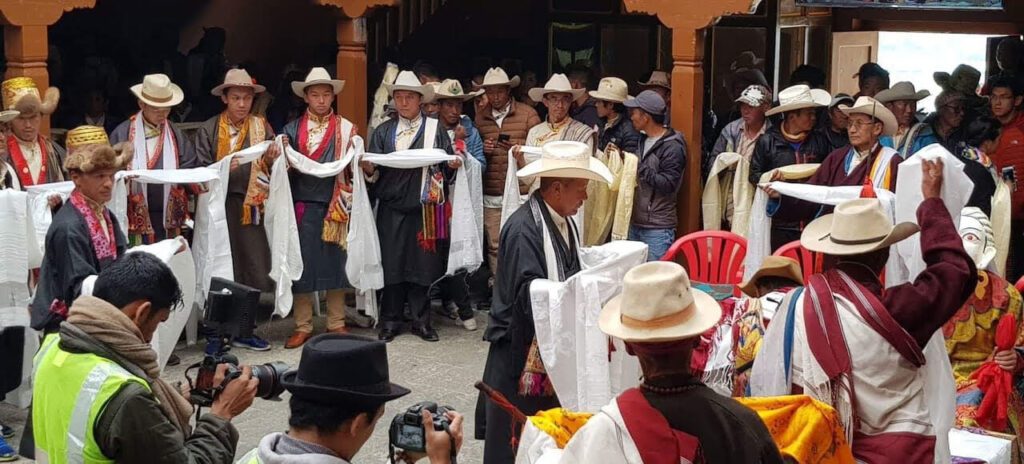Listen up, adventure seekers! Are you ready for a wild ride? Let me tell you about the Tengboche Monastery, the jewel of the Khumbu region in Nepal. Nestled in the lap of the mighty Himalayas, this Buddhist monastery is nothing short of a spiritual haven. It’s not just a religious site, my friends, it’s also a hot spot for thrill-seeking tourists. This place is the beating heart of the Everest region and a magnet for explorers from around the world. Trust me, this is one destination you don’t want to miss!

Tengboche Monastery is a must-visit destination at least once in a lifetime. The monastery’s spiritual atmosphere and stunning natural surroundings make it an unforgettable destination for everyone who visits.
Located in the Khumbu region of Nepal, Tengboche Monastery is a captivating destination for travelers seeking spiritual enlightenment and adventure. Nestled in the heart of the Himalayas, Tengboche Monastery is a cultural and spiritual hub that offers stunning views of the towering peaks that surround it. The monastery is also widely known as Thyangboche or Dawa Choling Gompa. The monastery is situated at an altitude of 3,867 meters and provides panoramic views of the mighty peaks of Ama Dablam, Thamserku, and Lhotse.
Location of Tengboche Monastery
Tengboche Monastery is a spiritual center located in the Khumbu region of Nepal, in the Sagarmatha National Park. Situated at an altitude of 3,867 meters (12,687 feet), the monastery is one of the highest and most spectacular religious sites in the world. Tengboche Monastery is known for its stunning views of Mount Everest and its surrounding peaks making it a popular destination for both spiritual seekers and adventurous travelers.

The monastery is located in the village of Tengboche which is situated on the ridge above the Dudh Koshi River. To reach Tengboche Monastery visitors must first trek through the rugged terrain of the Himalayas passing through small villages and steep mountain trails. The trek to Tengboche Monastery is an experience in itself with breathtaking views of snow-capped peaks, deep valleys, and rushing rivers.
The monastery is located in a remote and mountainous region of the globe surrounded by some of the world’s tallest peaks. Because of their remoteness, the monks of Tengboche have been able to preserve their traditions and practices that date back to the monastery’s inception. Its position also offers a unique viewpoint on the natural world with breathtaking vistas of the Himalayan terrain and its diverse flora and animals.
History of Tengboche Monastery
The history of Tengboche Monastery is both fascinating and ancient as it has served as a crucial center for spirituality in the region for centuries. Despite facing numerous challenges over the years, the monastery has persevered and become one of the most significant cultural landmarks in the Khumbu region. Its impact on the cultural and spiritual life of local people and also people from other regions has been immense.
Also Read: Buddhists Holiest Festival: Mani Rimdu Festival
The origins of Tengboche Monastery date back to the early 20th century when Tibetan monk Lama Gulu founded it in 1916. Lama Gulu, known for his Buddhist teachings and meditation, selected the site for the monastery due to its tranquil atmosphere and stunning vistas of the surrounding peaks. Initially, the monastery was a small and destitute establishment, housing only a handful of monks. However, over time it grew and prospered eventually becoming the largest and most important monastery in the Khumbu region by the 1950s.
In 1934, an earthquake caused severe damage to Tengboche Monastery which was subsequently reconstructed. Another significant event in its history occurred in 1989 when a fire broke out and destroyed the original monastery along with its valuable religious artifacts. Despite the devastation, the monks of Tengboche refused to be defeated and took on the arduous task of rebuilding the monastery from scratch. It was a massive undertaking that took almost a decade to complete. Finally, in 1999 the new monastery was finished and inaugurated in a grand ceremony attended by thousands of people.
The architecture of Tengboche Monastery
Tengboche Monastery showcases a distinct blend of Tibetan and Nepalese architectural styles that are typical of Tibetan Buddhist monasteries. The exterior of the monastery is coated in white paint and features intricate wooden carvings and several prayer wheels. The building stands on a stone platform. The primary structure within the monastery is the Dukhang which serves as the main prayer hall. It boasts a substantial central pillar adorned with depictions of events from the Buddha’s life. The walls of the hall are adorned with thangkas, traditional Tibetan Buddhist artwork, and also display various statues and religious relics.

The monastery also features several smaller buildings, including a library, a meditation room, and living quarters for the monks. The buildings are arranged around a central courtyard, which is used for religious ceremonies and festivals.
Trekking to Tengboche Monastery
Trekking to Tengboche Monastery is a popular activity for those visiting the Everest region of Nepal. Tengboche Monastery, also known as Tengboche Gompa, is a Tibetan Buddhist monastery located at an altitude of 3,867 meters in the Khumbu region of Nepal. The monastery is surrounded by the stunning Himalayan mountain range, including Mount Everest, and offers breathtaking views of the surrounding landscape.
The trek to Tengboche Monastery typically starts in Lukla, which is accessible by a short flight from Kathmandu. From Lukla, trekkers follow the Everest Base Camp trail, passing through several Sherpa villages and beautiful landscapes along the way. The trek usually takes around 5-6 days to reach Tengboche Monastery, depending on the route taken and the trekker’s fitness level.

The trail to Tengboche Monastery is challenging, with steep ascents and descents and high altitude, so it is important to be well-prepared with proper gear and acclimatization. Trekkers will need to obtain a trekking permit and TIMS (Trekkers’ Information Management System) card before starting the trek.
Once at Tengboche Monastery, visitors can explore the monastery and attend the daily prayer sessions held by the monks. The monastery also offers stunning panoramic views of the surrounding mountains, including the famous Mount Everest.
Festivals at Tengboche Monastery Region
If you plan to visit the Tengboche Monastery then make sure to check the festival calendar to experience the live events firsthand. As a thriving and distinctive cultural center, the monastery hosts several events throughout the year that offer visitors a glimpse into the colorful and diverse culture of the Sherpa people. These celebrations attract visitors from all over the world.
Mani Rimdu Festival
The Mani Rimdu Festival is a religious and cultural event that has been celebrated in the Tengboche Monastery in Nepal’s Solu-Khumbu region for centuries. It is a three-day event that usually takes place in the month of November during the full moon. The festival is an important occasion for the Sherpa community as it represents their rich cultural and religious heritage.

The festival is celebrated in the Tengboche Monastery, which is one of the most important Buddhist monasteries in Nepal. The monastery is located at an altitude of 3,860 meters (12,660 feet) and offers stunning views of the surrounding Himalayan mountains including Mount Everest.
The festival is named after the prayer flags, called “Mani” in Tibetan, and the ritual dance called “Rimdu” in Sherpa. The festival’s main highlight is the performance of the “Chham” or the mask dance, which is performed by the monks of the Tengboche Monastery.
Visual Representation of Good and Evil
The dance is a visual representation of the struggle between good and evil and is performed to appease the deities and ask for their blessings. The festival’s three days are marked by various rituals, including the construction and destruction of a sand mandala, which is a circular diagram made of colored sand that represents the universe in Tibetan Buddhism. The mandala is constructed by the monks over several days and is then destroyed on the third day to symbolize the impermanence of all things.
Another important aspect of the festival is the “Empowerment” ceremony, in which the monks offer blessings to the attendees. The ceremony is held on the second day of the festival and is meant to confer spiritual power and blessings to those who attend.
Dumje Festival
The Dumje Festival is a major cultural event celebrated annually in Tengboche Monastery, usually in the month of July. This festival is dedicated to Khumbila, the deity of the Sherpa people, who is believed to protect and bless the region. The festival is an important occasion for the Sherpa community, and it is marked by several days of festivities, rituals, and cultural performances.

The celebration of the Dumje Festival begins with a special puja or prayer ceremony that is conducted in the main prayer hall of Tengboche Monastery. During the ceremony, the monks of the monastery offer prayers and perform various rituals to honor Khumbila and seek his blessings. The ceremony is accompanied by the playing of traditional musical instruments such as the dungchen (long horns) and cymbals.
One of the most important aspects of the Dumje Festival is the offering of butter lamps. Devotees light thousands of butter lamps in and around the monastery, creating a spectacular display of light and color. The lighting of butter lamps is believed to bring good luck, health, and prosperity to the people and the region.
Cham Dance and Athletic Events
The festival also includes traditional dances and performances by the monks of Tengboche Monastery. The monks perform the Cham Dance, a sacred masked dance that depicts the victory of good over evil. The dance is performed with great enthusiasm and is accompanied by traditional music and chanting.
The Dumje Festival comprises a diverse range of customary pursuits and athletic events such as archery, horse racing, religious ceremonies, and cultural spectacles. The games constitute a crucial element of the festivities, delighting both locals and tourists alike. The horse racing component, in particular, is an exhilarating affair as it unfolds along a challenging course that meanders through the steep, rocky terrain of the Khumbu region.
Best time to visit Tengboche Monastery
Tengboche Monastery is located in the Solukhumbu district of Nepal, in the Himalayas. It’s a popular destination for trekkers and mountaineers who are looking to explore the region and experience its cultural and spiritual heritage.
You may also like: Khumbu Glacier Valley: Northeastern Heaven
The best time to visit Tengboche Monastery is during the spring and autumn seasons, which are from March to May and from September to November, respectively. During these months, the weather in the Himalayas is generally clear, with sunny days and cool nights. This makes for great trekking conditions, and you’ll have the best chance of seeing the stunning views of the surrounding mountains, including Mount Everest.
Monsoon and Winter
The monsoon season, which runs from June to August, brings heavy rain and fog, which can make trekking and travel difficult and dangerous. The winter season, from December to February, brings cold temperatures, snow, and ice, which can also make travel difficult and hazardous.
It’s important to note that the weather in the Himalayas can be unpredictable, and it’s always a good idea to check the forecast before traveling. Even during the best times of year to visit, there may be occasional storms or inclement weather that can disrupt travel plans. However, if you plan your trip during the spring or autumn months, you’ll have the best chance of experiencing clear skies and good weather
Tips
Tengboche Monastery is a beautiful destination for trekking in the Himalayas of Nepal. Here are some tips that may help you plan and enjoy your trek to Tengboche Monastery:
Get in shape:
Trekking to Tengboche Monastery involves a lot of uphill and downhill walking, so it’s important to be physically fit. You should start training at least a few weeks before your trek by doing cardio exercises, such as hiking, running, or cycling.
Bring appropriate gear:
Make sure you have the right gear for your trek. This includes comfortable trekking shoes, warm clothing, a waterproof jacket, a hat, gloves, sunglasses, and a backpack to carry all your essentials.

Acclimatize properly:
Altitude sickness is a real concern when trekking in the Himalayas. It’s important to take your time and acclimatize properly. You should plan for at least two days in Namche Bazaar, a popular stopover before Tengboche Monastery, before continuing further up. Make sure to drink plenty of water and stay hydrated.
Bring cash:
There are no ATMs or credit card machines in Tengboche Monastery, so make sure you bring enough cash to cover your expenses, such as food and accommodations.
Respect local culture:
Tengboche Monastery is a sacred place for the local Sherpa people. It’s important to be respectful of their culture and customs. Ask permission before taking photos and don’t touch any religious artifacts.
Hire a local guide:
Hiring a local guide is highly recommended. They can help you navigate the trails and provide valuable insights into local culture and traditions.
Popular: Trekking Gear Essentials
Be prepared for the weather:
The weather in the Himalayas can be unpredictable. It’s important to be prepared for all types of weather conditions, including rain, snow, and cold temperatures. Check the weather forecast before you leave and pack accordingly.
Leave no trace:
When trekking in the Himalayas, it’s important to leave no trace. This means taking all your trash with you and not leaving any litter on the trails. Help keep the area clean and beautiful for future trekkers to enjoy.







